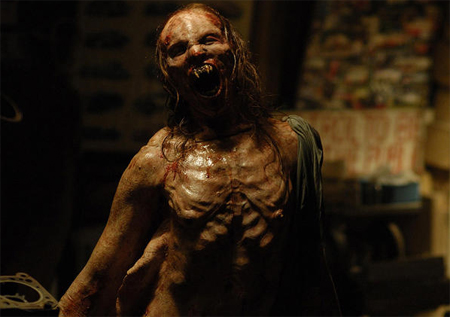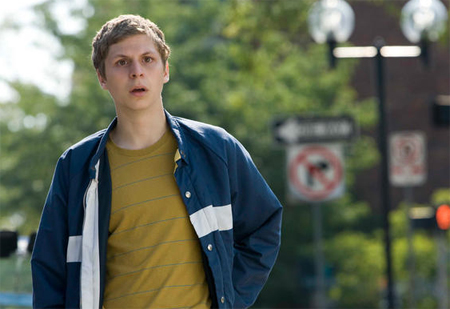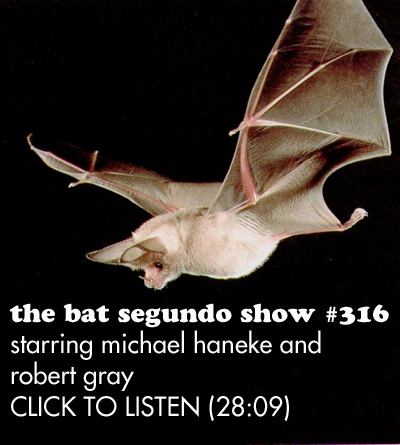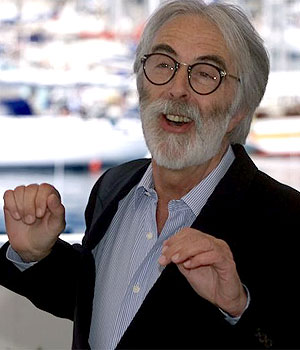Category / Film
The Most Important Absence
The above film, “The Most Important Absence,” is the first one I’ve made in 2010. And I intend to put together several more of them. All clips were taken from public domain sources — mostly stag and burlesque films from the first half of the 20th century. The title is taken from a very influential essay about image, which I leave viewers to seek out. But the content contained within the film will probably reveal its source. Different viewers will come away with different interpretations, but the onus falls upon the viewer to determine what the juxtaposition means and where the absence really lies. The film has been expressly designed to offer several possibilities. There is no uniform interpretation.

Review: Daybreakers (2010)

The vampire film has needed a kick in the ass for quite some time. Popular audiences have endured the emo complacency of the Twilight films, suffered through the soporific bastardization of Bram Stoker with 2004’s Van Helsing, and settled for the mediocre Underworld trilogy — all relying on tired and tedious tropes that have made recent vampire movies about as desperate as a burned out bookkeeper flipping through a community college catalog for a new hobby.
But Daybreakers is a vampire flick with a brain: a fresh and much-needed corrective to the past decade’s measly offerings. It may be the best American vampire film (courtesy of Australia) since the original Blade. The film manages to deliver on its premise, set ten years from now, largely because it has taken the time to consider the social implications of a world populated mostly by vampires. Cars are equipped with a Daytime Driving Mode, with tinted windows permitting vampires to drive during the day. City buildings are denuded of windows, modified to include corridors high in the sky. A Subwalk has emerged as an adjunct to the subway, which permits vampires to amble beneath an urban world, protected from daylight. Homeless vampires hold cardboard signs reading STARVING NEED BLOOD and bare their fangs at the rich. Cafes now offer coffee tinged with blood, and self-important yuppie vampires still berate baristas. There are even gated suburban communities, whereby those who provide the blood are rewarded with secure enclaves.
But when 95% of the population relies on human blood to survive, and humans are being increasingly munched on, there’s bound to be problems. As one vampire puts it, “Life’s a bitch and you don’t die.” Daybreakers presents blood as a commodity that is just as exhaustible as oil, offering a subtly creepy Hubbert’s Peak analogy that aligns nicely with the distressing prospect of human genocide. But when any commodity declines, the poor will be the first to suffer. And it isn’t too long before those vampires who cannot afford blood are transformed into wretched winged monsters and chained “traitors” are led in daylight before an assembled shaded audience to demonstrate the consequences of questioning big business.
This premise is buttressed considerably by Sam Neill camping it up as a sleazy industrialist and by Ethan Hawke (playing a vampire researching a surrogate for the diminishing blood supply) approaching this material as if he has been cast in an Ibsen play. Michael and Peter Spierig — the writer-directors behind this fun little flick — wisely understand that any good vampire movie requires these varying levels of performance. They’ve even managed to recruit Willem Dafoe as a former vampire turned human vigilante, who brandishes a crossbow and proudly announces, “My friends call my Elvis.” I can’t really complain much about the process that turns Elvis human. It’s about as plausible as the semi-cheesy procedure offered near the end of Kathryn Bigelow’s great flick, Near Dark.
The Spierig brothers give this film a suitable fluorescent look, where each individual vampire carries the combined pallor of twenty Peter Murphy acolytes. They don’t hesitate to depict starving vampires hungrily licking walls, and that desperate hunger reinforces the narrative stakes. The filmmakers flounder somewhat near the end, largely because their characters can’t always match the conceptual complexity. One can level the same minor complaint against District 9, which replaced its interesting take on race with fights and explosions. But then one expects this sort of thing from a movie of this type.
But Daybreakers must be lauded. It is a rare vampire movie that comes layered with so many intriguing ideas. The 2012-boosting Roger Ebert has dismissed it, because of “fierce fights and bloodshed.” But if you cannot accept a vampire movie with “fierce fights and bloodshed,” particularly with so many socioeconomic factors at stake, that’s too bad. For Daybreakers has thought out its setting with more alacrity than much of its duller non-genre counterparts.

Review: Youth in Revolt (2009)

Michael Cera, a reedy actor known for grilling his thin mix of thespic tricks into crepe-like pipsqueaks quietly braying the predictable coups de foudre, is not necessarily a man to be disliked. But there doesn’t seem to be a filmmaker with the guts to discourage his predictable instincts.
Miguel Arteta would seem to be that man. The director has served up a commendable body of work (the underrated Chuck & Buck, The Good Girl, and episodes of Six Feet Under and The Office) reflecting his knack for getting quirky and engaging performances from his cast. But it does not follow that, just because you affix a beret and a moustache onto Cera’s boyish poise, you will be guaranteed a performance that treads beyond established terrain. These sartorial embellishments, which emerge with Cera’s unconvincing puffs at jaspers, are intended to create an imaginary alter ego to Cera’s established protagonist. But the results demonstrate that Cera lacks the possibilities of an Elijah Wood, coaxed into enjoyable cartoonish viciousness by Sin City‘s Robert Rodriguez.
The Cera predicament is especially troubling for Arteta’s latest film, Youth in Revolt, which, my Cera criticisms aside, is a fairly engaging diversion — one that caused me to laugh, even when the needlessly condescending interstitials (various animations, disastrously calculated to appeal to some misunderstood Williamsburg demographic) threatened to uproot the delicious anarchy buried beneath. These concessional interludes caused me to wonder whether a few nonconformist kinks were ironed out during the reported reshoots early last year, and whether a more dangerous film, truer to C.D. Payne’s subversive source material, was lurking under the restitched seams. The film business, being as secretive and as protective as it is, will no doubt stay mum on this point.
Cera plays Nick Twisp, a teenager who is “a voracious reader of classic prose” and who likes Frank Sinatra. He complains that he lives “in a city filled with women who have zero interest in me” (honestly, in Berkeley?) and is mercilessly ridiculed when he rents La Strada from a video store. His mother has a taste for dumbbell fuck buddies (the first played by Zach Galifianakis, a noisy neo-Belushi whose supporting comedic turns I am becoming rather fond of). The promised Summer of ’42 moment emerges with a girl named Sheeni Saunders (played winningly by relative newcomer Portia Doubleday), who takes to Twisp’s naive disposition and expands her lips further after he unleashes an alter ego: a lumpen lothario named Francois Dillinger, the alter ego I quibbled with above.
Dillinger persuades Twisp to do bad things. Arson with $8 million in damages. A ruse involving sleeping pills. All in the service of winning Sheeni’s heart with dangerous behavior. Much of this is fun, but Cera’s plodding one-note performance prevents this gleeful mayhem from living up to the disastrous possibilities of a Frank Oz-directed comedy.
It is troubling that Arteta casts so many of his supporting actors right, while failing to elicit much out of Cera. Adhir Kaylan nearly steals the movie as Twisp’s pal, Vijay, imbuing his character with romantic neuroses that are far more plausible than anything Cera has to offer. Fred Willard is cast as a naive and burned out activist, and demonstrates once again that he’s brilliant at getting inside the surprisingly dimensional mentality of a clueless buffoon. I failed to mention that Jean Smart, who can do little wrong, plays Twisp’s mom. Even Steve Buscemi manages to show up as Twisp’s dad.
There are also some amusing oddball moments, such as Sheeni’s father revealed to be a lawyer, who proceeds to cite conditional legalese when Twisp arrives to hang out with Sheeni. Sheeni’s family lives in a preposterously baroque trailer with multiple floors. And in a surreal flourish, a car, for reasons that I won’t divulge, is trapped within the Twisp living room.
Many of these eccentricities existed in Payne’s novels, and they have been adapted well by screenwriter Gustin Nash (and uncredited polisher Mike White) into the requirements of cinema. It’s just too bad that Cera isn’t up to the material’s feral exigencies, and that Arteta (or some other unknown production force) has neutered the promise of a teen comedy as reinterpreted by Preston Sturges. This film is very good in spots, but why diminish the insanity?

The Bat Segundo Show: Michael Haneke
Michael Haneke appeared on The Bat Segundo Show #316. Mr. Haneke is most recently the director of The White Ribbon, which opens in theaters on December 30th.
The Bat Segundo Show expresses profuse gratitude and thanks to translator Robert Gray for assisting in this conversation, which is presented here in German and English.
Condition of Mr. Segundo: Tying a white ribbon ’round the old oak tree.
Guest: Michael Haneke
Subjects Discussed: The roots of human behavior within Haneke’s films, the film as a ski jump, the relationship between the cinematic spectator and semiotics, the spectator’s lack of freedom, the director as god and Martin’s spared death on the bridge, the baroness’s moral choice, truth and the denial of inherent human nature, Anna Karenina, social status and imprisonment, terrorist acts that are tied to specific occupations, the mistreatment of young children, planning a film for open-ended interpretation, whether or not a film can be entirely calculated for the spectator, the use of the Z-axis to accentuate a prewar setting, the perception of daily life, the role of the police in Haneke’s films, the trouble with dramaturgical constructs, and the impracticalities of theory in everyday situations.
EXCERPT FROM SHOW:
 Correspondent: In Funny Games, you have a scenario in which we don’t actually understand the motivations of the two killers. Cache, same thing. The actual motivation behind the videotapes is not entirely spelled out. And, of course, in The White Ribbon, we have a similar situation in which its more about the consequences than it is about the origins. And I’m curious why your films tend to not dwell upon the origins of terrible acts, as opposed to the consequences. Do you think that looking for the root cause of human behavior is a folly? At least with these particular characters in your film?
Correspondent: In Funny Games, you have a scenario in which we don’t actually understand the motivations of the two killers. Cache, same thing. The actual motivation behind the videotapes is not entirely spelled out. And, of course, in The White Ribbon, we have a similar situation in which its more about the consequences than it is about the origins. And I’m curious why your films tend to not dwell upon the origins of terrible acts, as opposed to the consequences. Do you think that looking for the root cause of human behavior is a folly? At least with these particular characters in your film?
Haneke: (through translator) Mainstream cinema raises questions, only then to provide immediate answers so that the spectator can go home feeling reassured. But I think if film is to take itself seriously as an art form, then, like every other art form, it has to allow the spectators a certain freedom of possibility — of investing themselves, of grappling with the issues that are involved, of bringing their own feelings and explanations to the work that they are receiving. I always say that not only film, but every art form should provoke the spectator so that they feel motivated. The work has to be constructed in such a way that the spectator is led to investing himself in search for his own answers. I always say that not only film, but books too, are like ski jumps. They have to be built in such a way that people can jump properly. But the film is the ski jump and it’s up to the spectator to jump.
BSS #316: Michael Haneke (Download MP3)
Listen: Play in new window | Download